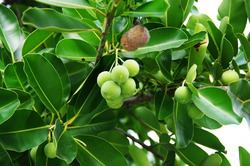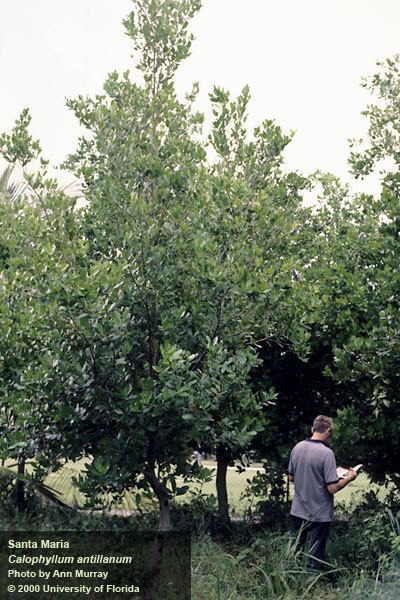Rank Species | Genus Calophyllum Higher classification Calophyllum | |
 | ||
Similar Calophyllum, Clusiaceae, Calophyllum calaba, Calophyllum soulattri, Calophyllum brasiliense | ||
Calophyllum antillanum is an evergreen, medium-sized tropical tree in the Calophyllaceae family. It is also known as Antilles calophyllum; Alexandrian laurel; Galba; Santa Maria; mast wood, beauty leaf, West Indian laurel.

It is prized for producing a very hard, durable wood. "The leaves were once used as a diuretic in Grenada, but it is said in Dominica to be poisonous (Politi, 1996). Famous hard wood . Very long lasting hut construction." It is considered an invasive weed species in some areas.


María wood is suitable for general construction, flooring, bridge construction, furniture, boat construction, cabinetmaking, shingles, interior construction, agricultural implements, poles, crossties, and handles. It is a good general utility wood where a fairly strong and moderately durable timber is required. In British Honduras, it was substituted for imported creosoted sleepers but required replacement after 3 or 4 years (24). In Mexico, attempts to use the timber in the veneer and plywood industry were not entirely successful.

The tree is also planted for shade along streets and as a windbreak or to protect against salt spray near the ocean. Frequently it is pruned to form a dense hedge along property lines in urban areas (28).

The latex from the trunk has been employed medicinally. The fruits are used as hog-feed, and lamp oil is extracted from the seeds.
The tree's adaptability to a variety of sites in Puerto Rico has made it popular among soil scientists and foresters for rehabilitation of degraded lands."
It is native to the Caribbean region, including Antigua and Barbuda; Barbados; Cuba; Dominica; Grenada; Guadeloupe; Hispaniola; Jamaica; Martinique; Montserrat; Puerto Rico; St. Lucia; St. Vincent and the Grenadines; Trinidad and Tobago; Virgin Islands (U.S.) - St. Croix. It has also been introduced to Florida and Hawaii In Trinidad it was used to make spinning tops for children. It has also been reported from Costa Rica, Colombia, Mexico, El Salvador, Puerto Rico, Ecuador, and Paraguay, etc.
Galba, its common name in Trinidad, may have been the origin of the stage name of Grenadian-born calypsonian, Sir Galba.
